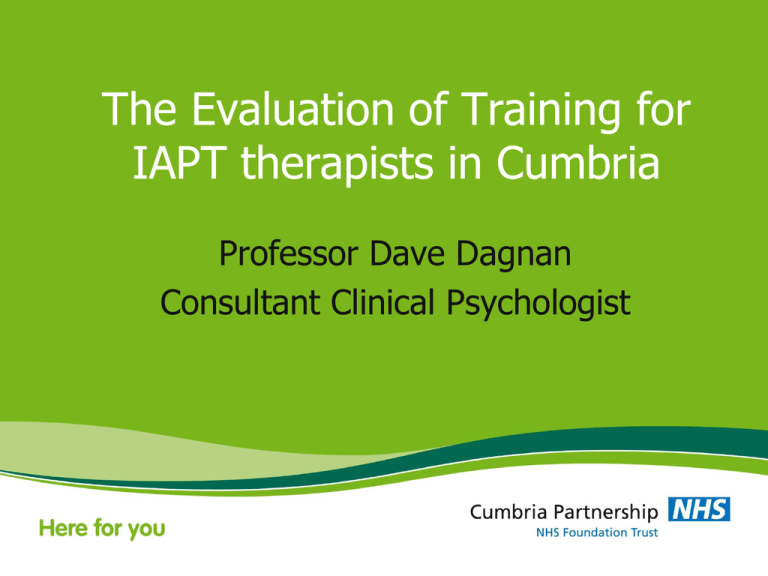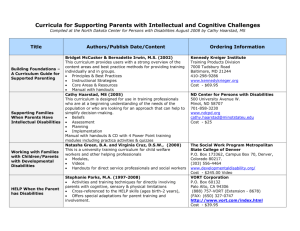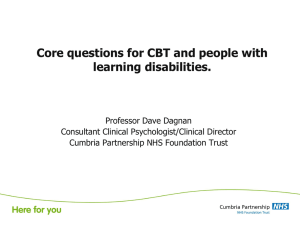Cumbria Partnership - The Evaluation of Training for
advertisement

The Evaluation of Training for IAPT therapists in Cumbria Professor Dave Dagnan Consultant Clinical Psychologist Using mainstream services. • There is increased emphasis on meeting the physical and mental health needs of individuals with learning disabilities within mainstream healthcare services, recognising that they should have access to the same services as the general population. • Attitudes and skills are often identified as key barriers to the use of services. Themes for training • Review of 13 high quality papers reporting outcomes of training needs analyses for non specialist staff who may work with people with LD Supporting adjustments in IAPT • Training for staff specific to their roles and the types of intervention supported by their part of the pathway. • Pathway adaptation, based on lower ability: • Easy read medication and self-help guides • Allowing extra time for reading core questionnaires • Emphasising less cognitively demanding techniques • Emphasising smaller set of techniques • Enabling supporters in therapy Overview • The 32 Primary Wellbeing Practitioners (6 men and 26 women) received one day of training consisting of 4 modules and the 36 High Intensity Practitioners (6 men and 30 women) received 2 days of training consisting of 8 modules. Training Curriculum • The training was structured in a modular format such that the training consisted of 4 or 8 modules depending on the duration of the training. • 1. Introduction to intellectual disability, epidemiology and impact of literacy and numeracy difficulties in the general population. - 2. Stigma and its impact on therapy relationships - 3. Introduction to assessment of people with intellectual disabilities - 4. Advanced assessment of people with intellectual disabilities 5. Overview of adaptation of therapeutic techniques 6. Specific examples of adaptation; thought diaries 7. Therapy approaches and formulation 8. Overview of local services and discussion of communication and support systems 1. The therapy confidence scale delivered pre-training, immediately post training and 3 months post training. 2. Five questions measuring general therapy selfefficacy and five questions measuring attitudes to the treatment of people with LD in mainstream services Qualitative Data • In order to add to the understanding of the effect of training and to gain insights from therapists when they had had a chance to reflect on the training in more detail, we interviewed six Primary Wellbeing practitioners and six High Intensity Practitioners at three months follow-up. The interviews were carried out face to face and were recorded and transcribed. Results • Significant difference in confidence between HI and PWP. • Significant increase in confidence for both groups maintained at 3 months Results • Significant positive change in attitude to mainstream treatment for both groups, maintained at 3 months Results • Significant difference in therapy selfefficacy between PWP and HI groups • Significant increase in general therapy selfefficacy in both groups, maintained at 3 months. Results • All interviewees were able to identify new skills and approaches they had applied since the training. The Primary Wellbeing Practitioners tended to identify specific adaptations that they had made subsequent to the training. • …..things like the questionnaire we fill in with the people, things like the PHQ and GAD, before I would give them to people and get them to fill them in and bring them back or give them to people and fill them in session, last time because I think I’m now more aware of that people may struggle with that, I always now say to people do you want to fill that in or do you want to go through it together and give them the option rather than embarrassing them by shoving it onto them. ….. The High Intensity Practitioners tended to reflect on more generalisable understanding of therapeutic issues. • I think the most helpful bit of it that stayed with us ….. Is the difference between cognitive deficit as opposed to cognitive distortion so that was quite helpful, in a typical population we are dealing with cognitive distortion in CBT ……it was really helpful I think for my thinking and working with people, not even learning disabilities working with people with personality disorder and things like that and thinking how therapy needs to be adapted when cognitive functioning or impaired or a guess different experiences in a person’s background mean they haven’t developed the skills that a lot of us take for granted problem solving, regulating negative emotions and things like that, but that’s the thing that stayed with us the most. All interviewees were able to describe case studies of working with clients with lower ability or learning disability that reflected many of the issues presented in the training. For example a Primary Wellbeing Practitioner described a case • …..he said he found particularly thinking was something he struggled with… erm so we took a problem solving approach which was much more concrete and thinking out different steps and planning different steps which ultimately got the same results which I would of got to with cognitive restructuring in a way that he can grasp more because it was more involving and thing about what actually doing than meta-cognitively • …. I could easily start to talk about feelings and thoughts using abstract examples, but I didn’t do that, I talked about his reactions to things and was able to get in that way and then explain to him that sometimes emotions feel stronger than others and again I was able to use his example to talk about when it was worse, when it was better, when it was happening That’s kind of where it went. If I was working with without the lower ability it would be a bit more abstract and then maybe I would talk quicker as well, with him it was vey much about his emotions and how they affected him and gave him an idea about you know what sort of influence that can have upon us Conclusions • Training seems to be effective in increasing confidence, increasing positive attitudes to people with learning disabilities in mainstream services and possibly in increasing general therapeutic self-efficacy. • Three month follow-up found most staff interviewed could describe ways in which the training had changed their practice. • Supported by work on developing clear pathways and protocols.











